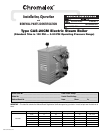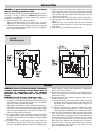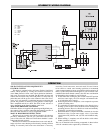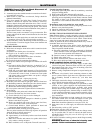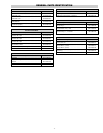
MAINTENANCE
WARNING: Hazard of Electric Shock. Disconnect all
power before working on boiler.
1. A monthly inspection should be made to ensure that all electri-
cal connections are tight.
2. When steam or water leaks are observed, fittings should be
tightened immediately.
3. Every four months, the Solid State Liquid Control probes
should be checked for deposits and cleaned if necessary.
Remove deposits from probe and teflon sleeve. This is accom-
plished by removing the inspection plate and with the use of a
standard spark plug wrench, removing the probes. Care should
be taken during the removal and reinstallation of the probes so
the porcelain insulator is not damaged.
The feed water probe is mounted in a surge isolator tube. This
isolator tube should be removed and cleaned at the same time
as the probes.
Note: Make sure that probe does not touch the insulator tube,
as grounding will occur. This will cause boiler to run dry.
4. At the same time, remove the heating element and inspect for
scale formation. If scale has begun to form, clean element and
also flush boiler.
TROUBLE SHOOTING HINTS
1. Boiler does not energize when main switch is turned on (noth-
ing happens).
A. Check to see if main power is turned on.
B. Check to see if control circuit voltage is turned on. (ON-
OFF switch has a pilot light)
C. Check power and control circuit fuses or breakers.
D. Check control circuit fuse on boiler.
E. Check all electrical connection for tightness.
2. Boiler power control circuit pilot light is on. Boiler will not fill
or heat.
A. No water in boiler. Check sight glass, it should be
1
/8 to
1
/2
full. Check water feed lines, valves, pumps, strainer, etc. for
proper operation.
B. Solid state water feed probe inoperative. Check solid state
liquid controls probes. Water feed solenoid should activate
10 seconds after control circuit is turned on. Clean probe
and isolator tube as required. Make sure probe is straight
and does not touch wall.
C. Water feed relay bad – replace plug-in relay.
D. Solenoid valve bad — replace solenoid valve.
3. Boiler has power and water in sight glass. Boiler will not heat.
A. Bad heating contactor. Check for open coil or frozen contacts.
B. Bad relay on control Board. Replace control board.
C. Burned out element. Replace heating element.
D. Loose power connection. Tighten electrical connections.
4. Boiler floods.
A. Check high water probe and isolator tube for deposits.
B. Check water feed relay for frozen contacts.
C. Check solenoid valve, may be stuck or damaged.
5. Element repeatedly burns out.
A. Low water cutoff probe damaged or shorted to ground.
Remove and check low probe.
B. Boiler not supplied with water. Check water feed lines,
valves and circuits. Check water feed probe.
C. Control board defective. Check operation of board and
component. Replace board if necessary.
6. Control board trouble shooting. Start-up sequence.
The two probe board has the following sequence of operation
when the boiler is initially energized.
A. Turn on control circuit power.
B. Approximately 10 second delay before water feed solenoid
or pump starts.
C. Water rises in boiler and contacts low probe which closes
relay contacts, turning on heater.
D. Water continues to rise to HI probe. Turns off water feed.
Normal Operation Sequence.
1. Water drops below HI probe. After 10 second delay, water feed
energizes refilling boiler.
2. Water reaches HI probe and turns off water feed.
3. Sight glass should be
1
/3 to
1
/2 full. Heater contactor will cycle at
operating pressure depending on load. Heater contactor should
not chatter on short cycle. In the event of contactor chatter,
check for low water condition and check for damaged or short-
ed probes.
Inconsistent water level causing low water cutoff.
1. Test feed solenoid control circuit by energizing control circuit.
Remove cover plate from probes.
2. Check for shorted or failed water feed probes.
3. Check water feed lines, valves and circuits.
INSTRUCTIONS FOR ELEMENT REPLACEMENT
Note: Element failure is usually caused by excessive scale build
up or low water operating conditions. Before replacing element, be
sure boiler tank is clean and free of scale. Check control board,
water feed system and control probes for proper operation.
Failure to perform the above maintenance checks may result in
immediate burn-out of new elements.
1. A monthly inspection of the boilers, boiler installation and
electrical wiring should be made to insure proper operation.
These inspections should include:
A. Electrical connections. Look for overheated or discolored
power terminals. Check and tighten all terminals that may
work loose from expansion and contraction.
B. Check for steam or water leaks and tighten all pipe fittings.
C. Check safety relief valve.
D. Check water feed line, strainers and check valves.
E. Blow down boiler and make sure drain lines are clear.
Read completely before starting work.
1. Disconnect boiler from electric power supply at main safety
switch or fuse panel. Then turn boiler switch to “off” position.
2. On automatic feed units, close valve on incoming water line.
Drain boiler completely of water.
3. Remove wiring compartment end panel to expose heating ele-
ment.
4. Disconnect wire (electric) leads connecting element to main
power system of boiler. Again note wire connections to facili-
tate re-assembly. Proceed to remove (6)
5
/16-18 bolts from
flange.
5. Thoroughly clean boiler flange of all foreign material. Be cer-
tain no part of old gasket remains on boiler flange.
6. Apply “Slic-Tite” Gasket Compound (or equivalent) to both
surfaces of new gasket supplied with replacement element.
Proceed to install element flange assembly with gasket
between boiler flange and element flange. In doing this, be
careful to align flange holes; element flange is marked “TOP”
so wire connection terminals on top element assembly will be
in line with previously disconnected wire leads to facilitate
easy connections.
7. When all (6) flange bolts are tight, connect all wires to termi-
nals. Make certain wires are clean and bright to assure good
electrical contact and nuts on screws are firmly secured.
Note: Bolts should be tightened to a torque of 22 ft. lbs.
8. Open water valve so water supply can reach boiler feed mech-
anism.
9. Put main safety switch to “ON” position.
10. Turn boiler switch to “ON” position.
11. As boiler automatically refills, observe the new flange assem-
bly for possible leaks. If water is noticed, the bolts must be
retightened. Before doing this, turn the boiler off at the main
fuse safety switch.
12. As boiler is heated to working pressure, check flange assembly
again for leaks.
WARNING: Avoid use of chemical cleaning com-
pounds. Follow maintenance instructions.
-4-



